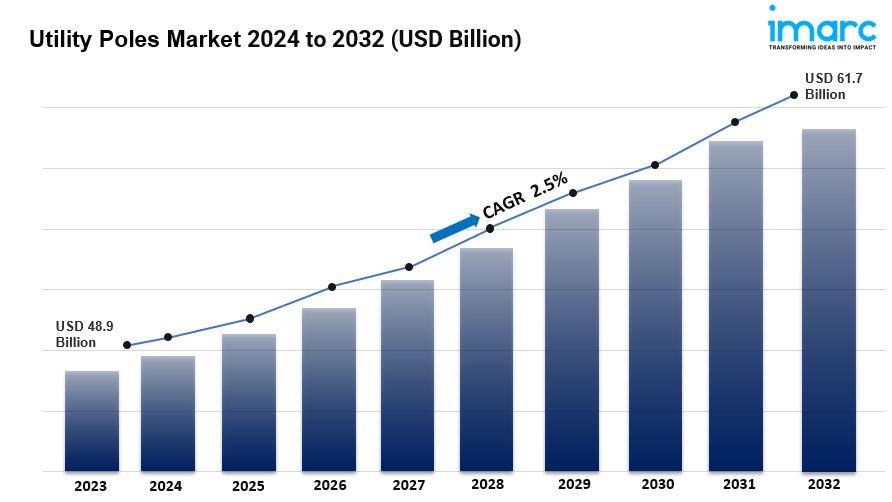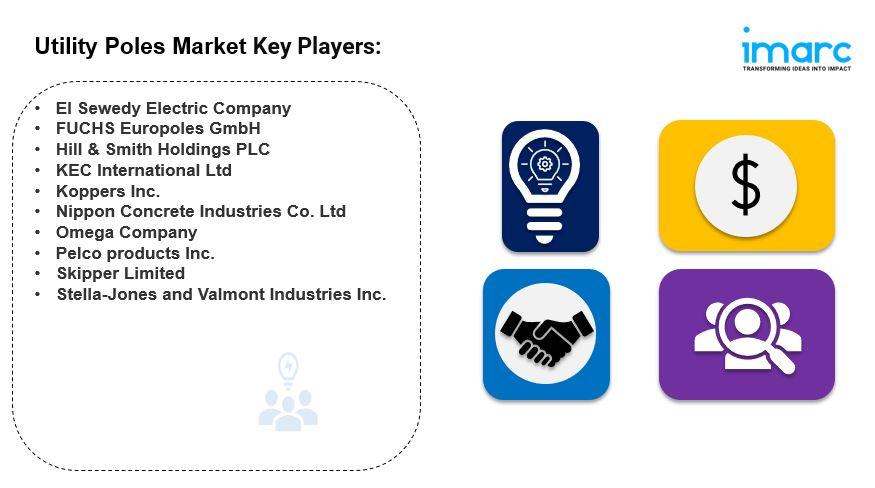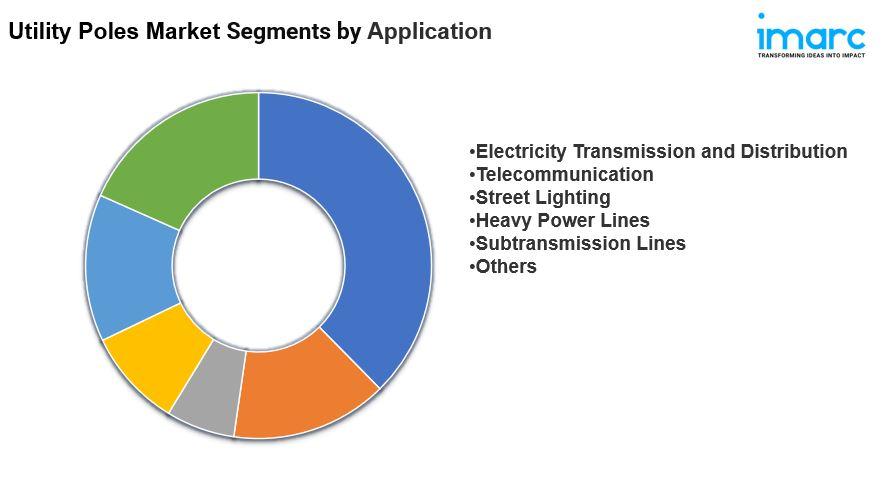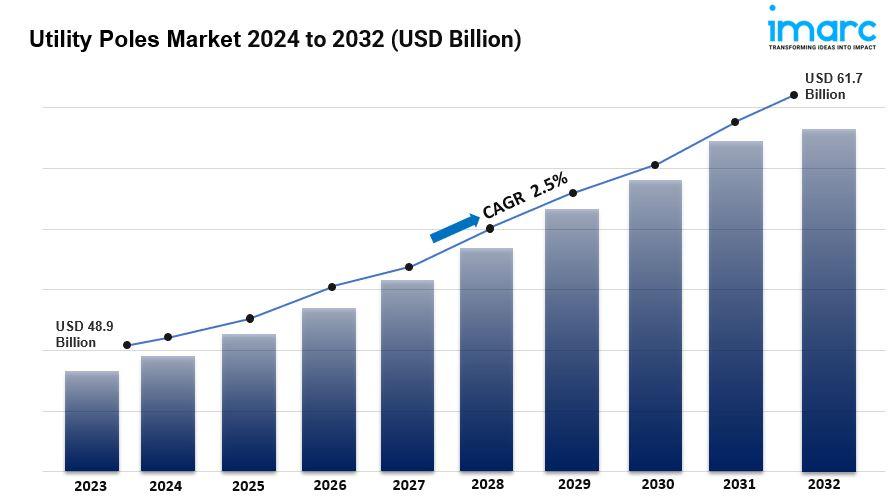IMARC Group has recently released a new research study titled “Utility Poles Market Report by Type (Transmission Poles, Distribution Poles), Material (Concrete, Wood, Steel, Composites), Pole Size (Below 40ft, Between 40 and 70ft, Above 70ft), Application (Electricity Transmission and Distribution, Telecommunication, Street Lighting, Heavy Power Lines, Sub transmission Lines, and Others), and Region 2024-2032”, offers a detailed analysis of the market drivers, segmentation, growth opportunities, trends, and competitive landscape to understand the current and future market scenarios.
The global utility poles market size reached US$ 48.9 Billion in 2023. Looking forward, IMARC Group expects the market to reach US$ 61.7 Billion by 2032, exhibiting a growth rate (CAGR) of 2.5% during 2024-2032.

Global Utility Poles Market Trends:
The increasing need for enhanced telecommunications infrastructure to support fifth-generation (5G) networks and rural broadband expansion requires new and upgraded utility poles to ensure robust and widespread connectivity supporting the market expansion. In line with this, government initiatives focused on improving grid reliability and resilience against climate change impacts, leading to investments in upgrading and fortifying utility pole infrastructure to withstand extreme weather conditions and natural disasters, aiding the market growth. Besides this, the increasing electrification of transportation infrastructure, including the installation of overhead lines for electric buses and trams, requires substantial new utility pole installations to support these emerging transit networks, contributing to the market demand.
Request to Get the Sample Report: https://www.imarcgroup.com/utility-poles-market/requestsample
Factors Affecting the Growth of the Utility Poles Industry:
Infrastructure modernization and expansion: As urbanization and industrialization progress globally, there is a significant push to modernize and expand existing utility infrastructure. Aging utility poles, many of which have been in service for decades, are being replaced to ensure reliable service and accommodate new technologies. This modernization effort is essential for maintaining the integrity of electrical grids and telecommunications networks, particularly in regions experiencing rapid growth and development. Additionally, the expansion of infrastructure into previously underserved or rural areas necessitates the installation of new utility poles. Governments and utility companies are investing heavily in upgrading and expanding their networks to support economic development and improve service reliability, thus strengthening the market growth.
Increasing demand for electricity: The global demand for electricity continues to rise, driven by population growth, economic development, and the proliferation of electrical devices and appliances. This increasing demand places greater pressure on existing utility infrastructure and necessitates the expansion and upgrading of electrical distribution networks. Utility poles play a critical role in supporting these networks, carrying power lines that deliver electricity to homes, businesses, and industries. Moreover, the transition towards renewable energy sources, such as wind and solar power, requires the integration of these sources into the existing grid. This often involves the installation of new utility poles to connect renewable energy installations to the main distribution network, impelling the market growth.
Advancements in materials and Technologies: Technological advancements and innovations in materials are significantly driving the utility poles market. Traditional wooden poles, while still widely used, are increasingly being complemented or replaced by poles made from steel, concrete, and composite materials. These materials offer superior durability, longevity, and resistance to environmental factors such as decay, pests, and extreme weather conditions. For instance, composite poles, made from materials like fiberglass, are lightweight, strong, and require less maintenance than traditional wooden poles. Innovations in pole design and manufacturing processes are also enhancing the performance and reliability of utility poles. Furthermore, the integration of smart grid technologies necessitates utility poles that can support advanced communication and monitoring equipment, bolstering the market demand.
Explore Full Report Description At: https://www.imarcgroup.com/utility-poles-market
Key Companies:
- El Sewedy Electric Company
- FUCHS Europoles GmbH
- Hill & Smith Holdings PLC
- KEC International Ltd
- Koppers Inc.
- Nippon Concrete Industries Co. Ltd.
- Omega Company
- Pelco products Inc.
- Skipper Limited
- Stella-Jones and Valmont Industries Inc.

Utility Poles Market Report Segmentation:
By Type:
- Transmission Poles
- Distribution Poles
Distribution poles account for the majority of shares because they are essential for delivering electricity to end-users, making them a dominant component in utility infrastructure.
By Material:
- Concrete
- Wood
- Steel
- Composites
Wood dominates the market due to its cost-effectiveness, availability, and sufficient performance for many utility applications.
By Pole Size:
- Below 40ft
- Between 40 and 70ft
- Above 70f
Between 40 and 70 ft pole size represents the majority of share because it is optimal for balancing structural support and installation flexibility in most distribution and transmission networks.
By Application:
- Electricity Transmission and Distribution
- Telecommunication
- Street Lighting
- Heavy Power Lines
- Subtransmission Lines
- Others

Electricity transmission and distribution exhibits a clear dominance as they are employed to support power lines for transmitting and distributing electricity across various regions.
Regional Insights:
- North America
- Asia-Pacific
- Europe
- Latin America
- Middle East and Africa
Asia Pacific enjoys the leading position owing to the rapid urbanization, infrastructure development, and population.
Speak to An Analyst: https://www.imarcgroup.com/request?type=report&id=4086&flag=C
Key Highlights of the Report:
- Market Performance (2018-2023)
- Market Outlook (2024-2032)
- Market Trends
- Market Drivers and Success Factors
- Impact of COVID-19
- Value Chain Analysis
- Comprehensive mapping of the competitive landscape
If you need specific information that is not currently within the scope of the report, we will provide it to you as a part of the customization.
Related Market Reports:
https://www.imarcgroup.com/tofu-market
https://www.imarcgroup.com/ice-maker-market
About Us
IMARC Group is a global management consulting firm that helps the world’s most ambitious changemakers to create a lasting impact. The company provide a comprehensive suite of market entry and expansion services.
IMARC offerings include thorough market assessment, feasibility studies, company incorporation assistance, factory setup support, regulatory approvals and licensing navigation, branding, marketing and sales strategies, competitive landscape and benchmarking analyses, pricing and cost research, and procurement research.
Contact us:
IMARC Group
134 N 4th St. Brooklyn, NY 11249, USA
Email: sales@imarcgroup.com
Tel No:(D) +91 120 433 0800
United States: +1-631-791-1145



